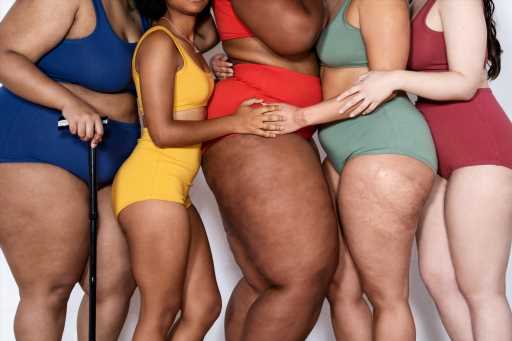Just as our vaginas and vulvas change as we age, so do our breasts. These changes range from how breasts look to how they feel, due to a myriad of reasons, including age, hormones, pregnancy, and breast cancer and reconstructive surgery.
We’re not typically briefed on the health and development of our breasts, except for maybe the typical health class spiel we receive in high school – like how they’ll grow and develop milk for babies to breastfeed – but that’s pretty much it. That’s why it’s important to know how our chest and breast tissue changes throughout the decades. We spoke with medical experts about how your boobs change as you age and why.
In Your 20’s
According to Dr. Alexander Zuriarrain, a board-certified plastic surgeon, the architecture of your breast changes and so often over time. “This is a slow process that is happening between the ages of 20 and 50 where women have a change from fibrous breasts to breasts that are composed mainly of fat,” he explains. “[Over time] the breast is not as firm. The older the female, the less dense the breasts tend to be.”
Then, of course, there are the obvious changes including weight gain and loss (which might explain why your bra size fluctuates with any changes in your weight throughout this decade) and pregnancy, which may or may not happen in your 20’s. (The average age of pregnancy in the U.S. is 27, according to the CDC’s latest report on maternal age).
Regardless, your breasts should feel firmer in your 20’s, and softer as time goes on. “Every decade causes the breast to soften,” Zuriarrain says. “This leads to less firmness that is normally seen during the 20’s.” That’s one of the reasons why it’s important to give yourself a self breast exam — you should get well acquainted with your breast tissue as early as your 20’s and understand how it changes over time, so you can be aware of any abnormalities that could signify a health issue.
In Your 30’s
If you’re a mother, which you are likely to be in your 30’s given CDC data on the increase of births in this category, you’re well aware that your breasts are not what they used to be.
“During pregnancy, your breasts are engorged with milk during pregnancy, and then involute after breastfeeding ends,” Dr. Constance M. Chen, board-certified plastic surgeon and breast reconstruction specialist, tells SheKnows. “Throughout this process, the breast skin stretches, and breast skin usually does not snap back completely. For this reason, older women will usually have more fatty breasts, and the breasts may also be more droopy, especially if they have had pregnancies and breastfed children.”
You might also notice the darkening of your areolas during pregnancy, and afterwards don’t be surprised to see some stretch marks.
In Your 40’s
There’s a strong chance you could be still having children and breastfeeding into your 40’s. But toward the middle and end of your 40’s, you’re likely to enter the period called perimenopause, the precursor to menopause, that often lasts around four to five years. Because your periods are tapering off and may be irregular during this time period, you can often experience breast tenderness as you approach menopause due to that shift in hormones, per the National Cancer Institute.
New guidelines state that you should now begin to schedule regular mammograms at age 40. Prior to turning 50, you should also be doing frequent breast self-exams once a month, feeling for irregular lumps and observing any nipple discharge, skin changes to the nipple or the surrounding skin. According to Zuriarrain, any evidence of crusting or scabbing with redness is an alarming sign that should be brought to your physician’s attention. While breast pain in general is not associated with malignancy, Zuriarrain advises seeing your physician if you’re experiencing any.
In Your 50’s
Once you hit 50, and you’re well into menopause, you might be taking hormones, such as hormone replacement therapy to treat symptoms of menopause like hot flashes or vaginal dryness, your breast tissue might become denser due to the increase in estrogen. The density could pose more challenges when a technician tries to read your mammogram results, but you should continue to go for an annual mammogram.
Typically, ultrasounds are also done at 50 years old and above for breast cancer screening purposes, says Zuriarrain. A full breast exam by a health professional is also encouraged for feeling lumps and bumps that could be alarming regarding potential breast cancer.
Breast cancer risk increases with age, and most diagnoses are after age 50, according to the CDC. With a diagnosis, breasts may or may not change depending on the treatment, says Chen. “If a breast cancer patient undergoes lumpectomy, then the breast will be smaller or may have indentations or irregularities after surgery,” she explains. “Lumpectomy is usually followed by radiation, which permanently changes the quality of the breast skin that has been radiated so it is no longer soft and supple and it will be permanently stiffer and smaller than the non-radiated breast. The radiated breast will usually be higher than the non-radiated breast for the same reason.” If a breast cancer patient undergoes mastectomy, then you will either be flat-chested or will undergo breast reconstruction to reshape the breast tissue afterward.
However, breast cancer risk is 2.40% in women over 50, so this is not to say that every woman will experience this process. While it’s important to be aware of your risk and any family history or potential breast cancer-related genes, it’s equally important to be aware of your normal —knowing how your breasts should change over time, so that you understand your body better than anyone else.
Before you go, check out these practical products for breast cancer survivors:

Source: Read Full Article

